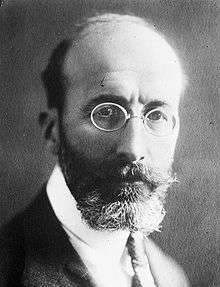Ramón Menéndez Pidal
| Ramón Menéndez Pidal | |
|---|---|
 | |
| Born |
13 March 1869 A Coruña |
| Died | 14 November 1968 (aged 99) |
| Nationality | Spanish |
| Awards | Real Academia Española |
| Academic background | |
| Alma mater | Complutense University of Madrid |
| Academic work | |
| Institutions | Centro de Estudios Históricos |
Ramón Menéndez Pidal (Spanish pronunciation: [raˈmon meˈnendeθ piˈðal]; 13 March 1869 - 14 November 1968) was a Spanish philologist and historian.[1] He worked extensively on the history of the Spanish language and Spanish folklore and folk poetry. One of his main topics was the history and legend of The Cid. He was nominated for a Nobel Prize.
Biography
He was born in A Coruña (Galicia), Spain.[2] His father, Juan Menéndez Fernández, was a lawyer and a magistrate, originally from Asturias. His mother was Ramona Pidal, also an Asturian. His older brother, Juan Menéndez Pidal, whom he outlived by more than fifty years, was also a literary scholar of folk poetry, expert in the poesía popular of Asturias. Another older brother, Luis Menéndez Pidal was a notable realist painter.
He studied at the University of Madrid.[2] In 1899 he obtained the chair in Romance studies in the same university, an appointment that he held until his retirement in 1939. In 1900 he married María Goyri, who in 1896 became the first Spanish woman to receive a degree in Philosophy and later, in 1909, became the first woman to attain a non-medical doctorate at a Spanish university. They spent their honeymoon retracing the geographic locales of the Poem of the Cid (Cantar de Mio Cid).
Menéndez Pidal was elected to the Spanish Royal Academy (Real Academia Española) in 1901, and in 1925 its director. However, he resigned this position in 1939 under pressure from the academics who wanted a Director more acceptable to the Franco regime. However, he was re-elected Director unanimously in December, 1947, and held that post for the rest of his life.
In 1910, he became the head of the philology section at the Centro de Estudios Históricos, a division of the liberal and Europeanising Junta para la Ampliación de Estudios, which also had sections devoted to medicine, physics, chemistry, and mathematics.[2] In 1914 the Centro founded the Revista de Filología Española, which would become the premier scholarly journal in the fields of linguistics, Medieval and Renaissance Spanish literature.
During the 1920s Menéndez Pidal published in rapid succession a series of major studies: Poesía juglaresca y juglares (1924) traced the development of minstrel poetry in medieval Spain. Orígenes del español (1926), a landmark in Romance linguistics, retraces the pre-literary phase of the Ibero-Romance dialects, and the "triumph" of Castilian. A ballad collection, designed for the general public, Flor nueva de romances viejos (1928) became a best seller, and includes some versions of ballads that Don Ramón had authored himself. Finally, La España del Cid (1929) traced the career of the 11th century warrior lord, Rodrigo Díaz de Vivar, in a scholarly biography of some 1000 pages.
After the civil War, Don Ramón forcibly became an "independent scholar" and revised much of his earlier work. However, from this period is his sweeping essay "Los españoles en la Historia," a study that traces the struggle between liberals and conservatives in the entire course of Spanish history, he summarised his findings on the ballads in Romancero Hispánico: Teoría e historia (1953) a treatise that has not been superseded, and applied his theory of the origins of epic poetry to French literature in La Chanson de Roland y el neotradicionalismo (1959).
Menéndez Pidal worked for many years on a comprehensive history of the Spanish language, which he could not complete in his lifetime; the two volumes have been published posthumously as "Historia de la lengua española" (200%).
In 1956, alone, he received over 160 nominations for the Nobel Prize in Literature, but never won (that year the award going to Spanish author Juan Ramón Jiménez). He was nominated for a Nobel prize 23 times.[3][4]
Major works
- La leyenda de los siete infantes de Lara (1896)
- Crónicas generales de España (1898)
- Manual elemental de Gramática histórica española (1904)
- El dialecto leonés (1906)
- Cantar de mio Cid: texto, gramática y vocabulario (1908-1912)
- Orígenes del español (1926)
- La España del Cid (1929)
- La idea imperial de Carlos V (1938)
- Reliquias de la poesía épica española (1952)
- Romancero hispánico (1953)
- En torno a la lengua vasca (1962), recolle traballos anteriores
- El padre Las Casas: su doble personalidad (1963)
References
- ↑ "Ramon Menendez Pidal", Almanac of Famous People (2011) Biography in Context, Gale, Detroit
- 1 2 3 "Ramon Menendez Pidal", Contemporary Authors Online (2003) Biography in Context, Gale, Detroit
- ↑ "Wikidata Query Service". query.wikidata.org. Retrieved 2016-11-09.
- ↑ "Nomination Database". www.nobelprize.org. Retrieved 2016-11-03.
External links
- Ramon Menendez Pidal Foundation
- Disputa del alma y el cuerpo y auto de los reyes magos (1900)
- Discursos leídos ante la Real Academia Española (1902)
- Primera crónica general (1906)
- El romancero español (1910)